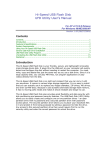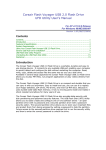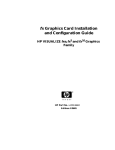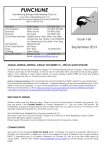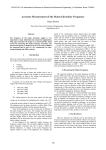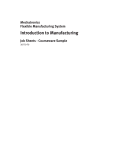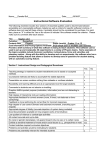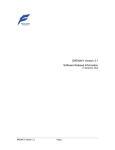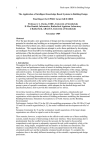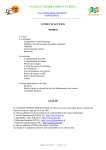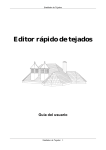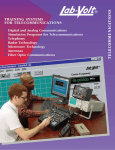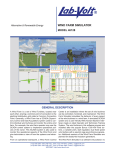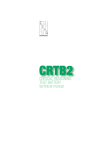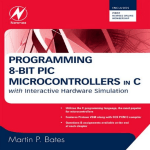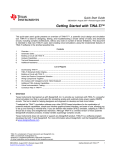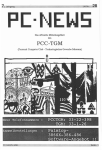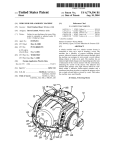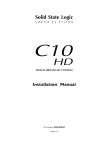Download The route to simulation III
Transcript
PC ENGINEERING Has Tina’s third incarnation – Tina Pro – been worth waiting for? Rod Cooper investigates. The route to simulation III Review subjects The first review covered Electronics Workbench version 5.12, whose maker is IIT Ltd of Canada. Workbench’s UK supplier is Adept Scientific plc, tel 01462 480055. Electronic Workbench’s price is £199. Rod looked at CircuitMaker in the August issue. This £199 package is made by MicroCode in the US and supplied by Labvolt in the UK, tel. 01480 300695. Subsequent reviews will cover Labcenter’s Lisa, which is part of Proteus IV, and Pulsar and Analyser from Number One Systems, which are modules from the Easy PC package. 738 T ina is a relative newcomer to the UK. It was first reviewed in Electronics World in the September 1996 issue by Clive Ousby. I recommend that you take a look at Clive’s review to get a broader view of the program. The original Tina program was upgraded to Tina Plus, and it has now been further developed into the new Tina Pro. The main differences in Tina Pro include a change to 32-bit operation, a much improved schematic drawing program, an expanded model library, and several extra analyses. This is a big leap forward by any standard. The latest version 5.21 of this new program has become a useful wide-ranging generalpurpose program. The minimum system requirements are a 486DX, 16Mbyte of RAM, at least 15Mbyte of disk space to install, and Windows 95 or 98 or NT4.0. There is no Windows 3.1 version. The copy of Tina Pro provided for review was on a CD, and installation was straightforward. Security is a little more complex than with other programs though. A registration number is provided with the CD. The owner has to contact the supplier or e-mail DesignSoft and exchange this number for a unique security number. This can take a while, but the package can be used up to 15 times without the security key, at which point the program will not run again until the number is entered. The security key is specific not only to one computer but also the directory it is installed in, so the program cannot be moved. As an alternative, some versions are dongled. In practice, using e-mail, the security key took just three days to arrive. Documentation The user manual has been rewritten, and now has a less academic approach than previous versions. It follows the current trend of many Windows applications in being a small volume, without an index or glossary, giving just the bare essentials. More reliance is made on the program’s Help files. Of the programs reviewed, Tina has the least reading matter. The program help files hierarchy has considerable depth, but the files themselves are sometimes brief. There is a set of tutorials which are more helpful – especially for those new to using the Tina system. These run either from the program CD, when there are 20 tutorials available, or alternatively, they can be accessed from the Help menu, in which case you get 25. The advantage of accessing them from ELECTRONICS WORLD September 1999 PC ENGINEERING the Help menu is that you can refer to a specific tutorial during work on your circuit, perhaps to refresh your memory on a particular topic, then flip straight back to the circuit. To do this, the tutorials need to be transferred to the hard disk during the main program installation. Although they take up 15Mbyte, it is well worth the hard disk space. There is also assistance in the form of a self-running demonstrator CD. I did not find the manual, Help files, or the demonstrator very useful individually. When they are combined with the tutorials though, it was possible to get up and running fairly quickly, especially as the program is largely intuitive. Schematic drawing Symbols are presented in generic form in a series of twelve pre-stocked symbol parts-bins. They include a set of virtual instruments, probes, and measuring tools, so Tina is fine for on-screen experimentation. It is possible to add to and modify the content of these parts-bins via an editing tool. The symbol library is backed by a library of 10000 component models – a doubling over the previous version. Mouse operation in Tina is straightforward; click left to commence, click right to finish, click left to select an existing symbol and right to edit via a sub-menu. There are no complicated left-plus-right routines to memorise. This system is carried over into the simulations. Fig. 1. A Tina schematic, showing how the virtual instruments are wired into circuit, much like Electronic Workbench, top, and the virtual oscilloscope expanded to show the controls, left. Wiring up The wiring up part of the schematic editor is a big improvement on previous versions. It is now possible to wire up symbols quickly and easily, and just as quickly delete them. To wire up you can either click right and choose this function, or simply move the cursor to a symbol terminal, when it changes to a drawing pen, and off you go. You can choose whether to wire manually or automatically. Autowiring is not like the systems found in other programs, but is more of an assisted manual method. Both systems were pleasant to use. Wires under construction can be deleted by reversing the track, and whole wires can now be deleted by selecting them with the right mouse button and picking ‘delete’. Previously they had to be deleted section-by-section. However mistakes – wires ending in space for example – are not automatically deleted. The schematic drawing is orthogonal. It is possible to move the symbol September 1999 ELECTRONICS WORLD Fig. 2. Input impedance graph, and symbolic analysis of input impedance. A semi-symbolic form, i.e. with values inserted, can also be obtained. 739 PC ENGINEERING Fig. 4. Analysis of gain and phase, expanded to run full-screen for easier measurement. Fig. 5. Typical digital timing chart of a counter circuit with glitch control set at 60%. text around to make neat diagrams. Junction dots are automatically inserted and symbol annotation is carried out as you go along. Wiring is assisted by a dot grid and a good but non-adjustable snap-to function makes for a good degree of reliability in net-list generation. ‘Undo’ and ‘Redo’ functions have been added, with unlimited levels. It is now possible to extricate yourself from most mistakes without too much trouble. There is no electrical rules check to look for possible mistakes like unconnected pins and shorts, and there is no autosave feature. If you want to export your net list to a pcb program, you can do so in Orcad, Tango, PCAD, Protel and Redac formats. Although Tina Pro’s symbol library is well-stocked, it is possible to add 740 your own symbols as there is a dedicated symbol drawing section. This is a good concept. The symbol drawing program is started separately from the main program, via the Tina start menu. Drawing symbols from scratch using this editor and then implementing them was easy. You can attach Spice models to these symbols. Another self-contained section enables Spice macros to be added. Simulation Tina Pro is described as Spice 3F5 compatible and features a native mixed-mode simulator. There are seven main virtual instruments for performing analyses; an oscilloscope, a signal analyser, a function generator, a digital signal generator, a logic analyser, a digital multimeter, and an XY plotter. When expanded, these instruments all have the appearance of real instruments, similar to the ones in Electronics Workbench. In addition there are several other measuring tools, including a power meter and impedance meter. The manual and help files do not describe these meters as well as those in Workbench or CircuitMaker do. However, in most cases it is not difficult to find out what they are, and what they are capable of, simply by trying them out. The method of use for the oscilloscope, signal analyser and multimeter instruments is to select these as icons from the parts bins – or component bars, as they are called in Tina – and wire them into the circuit diagram. The other virtual instruments can be selected from the T&M menu and connected via a virtual probe. Instead of expanding an instrument icon to see the controls, etc., as in other programs, the system in Tina is to pick the instrument you want to adjust from the T&M menu. You then get the complete virtual instrument on the screen in a set size. Instruments cannot be resized or run full-screen, but they can be moved around Windows-style in order to fit in more instruments or to look at the circuit diagram. A typical instrument – an oscilloscope – is shown in Fig. 1. Alternatively, you can set up the virtual instrument from a short-form menu by clicking right on it but I did not find this method very useful. Generally speaking the range and extent of the virtual instrumentation was good. Several of the meters from the meter parts bin are noteworthy. The power meter will be of interest to those of you involved in AC power circuits as it can give power factor, apparent power, reactive power, and phase. This is done not through a virtual-instrument type interface, but via the ac analysis nodal voltage dialogue box. It is not intuitive. To see the detailed readings, you have to place the probe on the power meter. The other instrument that caught my eye was the impedance meter. This system is more direct than that in CircuitMaker. It is easy to use and intuitive. An example giving a graph of input impedance versus frequency of an active filter is shown in Fig. 2. By using the nodal voltage probe, as with the power meter, you can get values for admittance and phase. The oscilloscope is not restricted to two channels as it is in Workbench for example. It can function like a ELECTRONICS WORLD September 1999 PC ENGINEERING normal oscilloscope or in storage mode. Besides the virtual instruments, you can run analyses by fixing probes/instruments in place and selecting the type of analysis you require from the menu system. DC and AC analyses, and transient, and noise analyses are handled this way. Where appropriate, Nyquist graphs can be displayed – an unusual and interesting feature at this level. All these graphs can be run full-screen for easy measurement. A typical AC analysis run from a menu is shown in Fig. 3. The above-mentioned analyses can be modified from the ‘mode’ menu. This is a blanket system of applying temperature-stepping, parameterstepping, worst case, optimum and Monte Carlo graphing methods to the above analyses. This is a logical way to organise these analyses. It is possible to obtain a Fourier series or spectrum of thd. An easy and direct method is used. Symbolic analysis can be performed to obtain an expression for the response of DC, AC and transient analogue simulations. For a low-cost simulator this is another unusual feature. It provides an alternative view of the behaviour of analogue circuits, particularly for some second-order effects. Other arguments for it include better insight and understanding of the circuit under test. In addition, teachers may regard it as useful for instructing students. Figure 2 shows a typical result. Digital analysis can be run step-bystep as well as normal mode. There is no coloured-wire system for clarifying more complex circuits, as in Electronic Workbench, but there is a pin-colouring system which gives some help on complex circuits. In digital simulation, there is good control over glitch threshold value. Like many other simulators, Tina has a fixed threshold system for showing glitches, in this case the default value being 50% of the delay of the digital devices. However, this can be overridden with a value set by the operator, which makes it a much more useful system. Lowering the percentage reveals more glitches, i.e. those with shorter duration, and vice versa. Again, this is implemented in a way that is simple and easy to use. The simulator section has a strong educational bias. Faults can be set, an equation editor is provided to insert formulae into the schematic, and there is even an ‘Exam’ mode. Another interesting feature of this program, which is noteworthy even if not really connected with simulation, is the availability of plug-in boards to provide real-time measurements from actual circuits. Results can be displayed alongside the predicted results to show up any discrepancy. In summary The first thing that existing Tina users will notice is how much improved the schematic drawing section is, compared to previous versions. It can now be said to be pleasant to use. In the simulation section, the range and scope of the basic analyses offered in Tina Pro are excellent. All of the basic requirements of a simulation program as listed in the introduction are met. In addition, there are specialist features, like the power meter, Nyquist diagrams, and symbolic analysis, not found in other products at this price level. The small written manual, brief Help files, and the style of the program give Tina Pro a medium-steep learning curve. I think a user manual September1999 ELECTRONICS WORLD comparable to that in CircuitMaker or Electronic Workbench would make the learning curve gentler and increase its appeal to many potential users – especially first-time CAD users. But Tina Pro would certainly suit those with even a modicum of experience in simulation. The package is aimed at both the educational market, as it has many features only of use in this particular field, and at the design-engineer. Just as with other programs with an educational bias like Workbench and CircuitMaker, there is much to attract the practical designer. To Tina’s credit, about 1Mbyte of the educational features can be omitted during the installation process if you wish. For engineer and educationalist alike, Tina is good value for money. It’s £100 more than Workbench or CircuitMaker, but the extra features make it well worthwhile. Tina continues to show rapid development, with an original approach, and promises to be one of the main contenders in this market sector. ■ Fig. 5. The same chart as Fig. 4, but with a slightly enlarged timing chart, and with the glitch control set to 10%, showing the relevant glitches. Tina Pro V5.2 by DesignSoft UK supplier; Quickroute Systems tel. 0161 4760202, fax 0161 4760505, price £299 for Tina Pro Industrial. Tina Pro Student version £49, Tina Pro Educational, £179. All prices exclusive. Site licences available; contact Quickroute. 741




